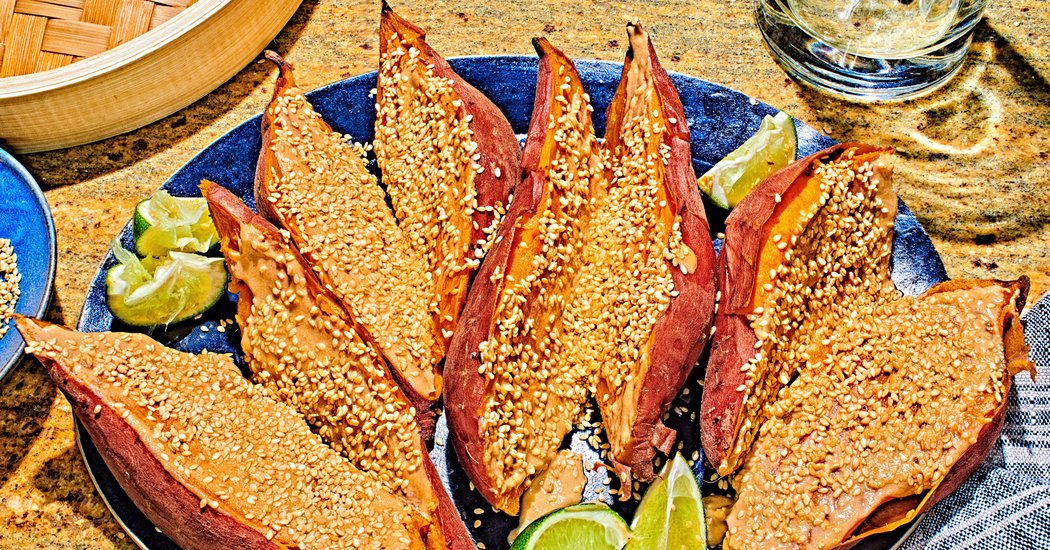
At some point during every cooking class I teach, I do my signature move: dramatically add handful upon handful of salt to a large pot of boiling water, then taste it and add even more. Across the room, eyebrows shoot up. Audible gasps are made. More often than not, someone (usually a man) will suggest that I’ve overseasoned the pot. But then I cook broccoli or green beans or asparagus and serve everyone. The first bite makes my point better than any words ever could: Vegetables need to be salted properly as they cook in order to taste good.
And yet, every time, someone timidly raises her hand and asks, “How do you feel about steaming?”
“Well, to be honest,” I usually respond, “I hate it!” Why steam when I can boil, allowing my food to become evenly salted from within? Steaming offers no opportunity for either seasoning or developing the brown, crisp textures that sautéing and roasting afford. The only good things I’ve seen emerge from a steamer are tamales, couscous and dumplings — maybe the occasional artichoke or delicate fish fillet. But baby turnips with their tender greens still attached should be boiled in water as salty as the sea until their flesh is silky and soft. Long-stemmed broccoli should be tossed with olive oil and flaky salt and roasted in a hot oven until the florets turn the color of hazelnut shells and shatter on the tongue.
So I was surprised to find myself fascinated by a recipe for steamed sweet potatoes in “Where Cooking Begins,” the new cookbook from the food writer and editor Carla Lalli Music. The accompanying photograph of a platter of still-hot sweet potatoes split open, doused in tahini butter and showered with sesame seeds and fresh lime juice sitting seductively in golden-hour light was so enchanting that it challenged my career-long aversion to steaming. I almost always cook sweet potatoes the same way: sliced into thick rounds, brushed with coconut oil, salted and roasted until dangerously dark. The crisp, salty edges, haunted by a rumor of the tropics from the oil, contrast with the creamy interior. The combination is so irresistible that I usually eat a few pieces, still blazing hot, straight from the baking sheet, inevitably burning my fingertips and tongue in the process.
But Music’s potatoes practically beamed off the page; I would have to try the recipe. I still refused to spend $8 on a metal steamer, though — I was certain I’d never use it again. Instead, I set a footed colander inside my stockpot, added a couple of inches of water and laid several small, pale-fleshed Japanese sweet potatoes inside to cook. As they steamed, I mashed together tahini and softened butter, wondering — with some annoyance — why I’d never thought to combine the two myself. The butter takes the tahini from spoonable to spreadable. I added the soy sauce, sesame oil and lime juice, then waited impatiently for the sweet potatoes to finish cooking.
When they were done, I ripped one open, salted and spread tahini butter over it, then stood eating it over the sink. Steam had fluffed the potato into a sponge, ready to absorb the golden butter as heat transformed it from solid to liquid. I gobbled up that first potato and, licking my fingers, forced myself to stop — I’d forgotten there was a table of dinner companions waiting in the other room. Once I managed to serve them, we all agreed that steaming had performed some kind of alchemy that roasting never does.
Over the next few days, I couldn’t stop thinking about the dish, so I made it a second time with orange sweet potatoes, spiking the tahini butter with a little more soy sauce and some pounded garlic because I knew potatoes could take a little more umami and pungency. Now the sauce made my mouth smack. I lavished lime juice and toasted sesame seeds over the platter and called over my neighbors. As I watched them eat the hot potatoes, unable to resist taking another bite even as the threat of burning their tongues loomed, I explained how incredibly simple the recipe was, realizing with a start that Music had turned me into a steaming evangelist.
Music has always struck me as a cook just as obsessed with salt, fat and flavor as I am, so I was curious to know why she chose to steam rather than roast the potatoes. “Well, steaming is one of the core cooking methods that I felt I needed to include in the book,” she began, “but I’ve always felt like it’s [expletive].” Laughing, she explained over the phone that her one exception has always been sweet potatoes, which she got into steaming for baby food after her first child was born. The potatoes, she said: “are so fibrous and they have so much of their own natural moisture that they’re actually a terrible vegetable to roast, and I don’t understand why people are constantly roasting them. Roasting just makes them more fibrous and leathery, and they never, ever really get crispy.”
Music may have changed my feelings about steaming — at least when it comes to the sweet potato — but I’ll never be much of an ascetic in the kitchen. I asked her if, like me, she views the method as little more than an opportunity to make a salty, creamy, acidic and umami-packed accompaniment. “Absolutely,” she replied without hesitation. “The tahini butter might seem like too much until you start eating it. And the lime wedges aren’t a suggestion — you need them to balance out the potato’s overwhelming sweetness.”
That was all the permission I needed to start viewing broccoli, green beans, cauliflower and beets as blank slates ready for the creamiest, most savory sauces I could dream up. As soon as I got off the phone with Music, I ordered a steamer basket. I even splurged on the fancy $18 one.




